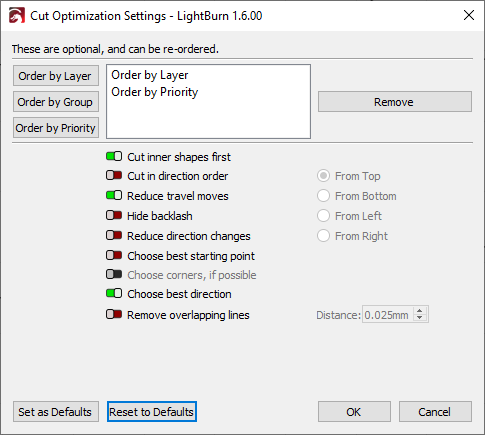Optimization Settings (Cut Planner)¶
LightBurn's Cut Planner controls the order in which LightBurn cuts your project. The Cut Optimization Settings window lets you adjust the variables by which the Cut Planner decides on cut order and pathing.
By default, the Cut Planner is set to Order by Layer followed by Order by Priority, with Cut inner shapes first and Reduce travel moves enabled. As you modify these settings, you can use the Preview window to see the effects.
Open the Cut Optimization Settings window by pressing the Optimization Settings button in the Laser window:
The screenshot below shows LightBurn's default settings. See the descriptions below for further explanation of these options.
Order By¶
The Order By section allows you to select the initial ordering parameters for your projects, which is the primary way in which LightBurn decides the order of cuts. You can choose from Layer, Groups, or Priority, and can also combine any of these parameters. When determining the order of cuts, LightBurn will take all the shapes in your project and split them into lists based on the parameter(s) you have selected.
If you select multiple parameters, the order is important. After splitting all the shapes in your projects into lists based on the first parameter, LightBurn will then split each of those lists based on the next parameter in the list. This process is repeated for however many parameters you have selected.
As an example, with the default settings shown in the screenshot above, LightBurn will first split all the shapes up into lists based on the layers you've created, and will then sort the shapes in each layer based on the priority you've set for each shape. Each set of shapes created through this process is then optimized with the options in the lower section of the window.
Order By Layer¶
Select Order By Layer to have the Cut Planner apply all remaining optimizations to the first layer, then the second layer, and so on.
Order By Groups¶
Select Order by Groups to have the Cut Planner apply all remaining optimizations to all the objects in a root-level group, then the next Grouped object, and so on. Ungrouped objects will all be treated as a single group for the purposes of this setting. This can be useful for cutting large projects where you may want an entire multi-layer item to complete before moving on to the next item.
Order By Priority¶
Select Order by Priority to have the Cut Planner apply all remaining optimizations to the objects with the highest priority first, then the next highest, and so on until all shapes are handled. Priorities are assigned in the Shape Properties window.
Optimizations¶
These optimizations are applied to each list of shapes created by the ordering rules described above.
Cut Inner Shapes First¶
If there is an object within another object, and both are being cut, cut the inner object before the outer one. This if often used to ensure engravings and inner cutouts are completed before cutting a shape out of the stock material, which can cause the shape to drop or shift, depending on how the material is held in place.
Cut In Direction Order¶
The Cut Planner will try to cut the shapes in your project in the specified direction - top to bottom, left to right, etc.
Reduce Travel Moves¶
The Cut Planner will try to reduce non-cutting travel moves by ordering cuts based on proximity to other shapes.
Reduce Direction Changes¶
The Cut Planner will try to choose nearby cuts that allow it to keep moving in the same direction, which keeps the laser moving faster.
Hide Backlash¶
This option is similar to the Backlash Repay Optimize setting found in RDWorks — it produces a cutting order that reduces or eliminates the misalignment between the start and end points of a cut caused by loose or flexing belts, or other forms of play in the mechanical parts of the laser. Enabling this option will force some of the other options to give it the most flexibility when planning the cutting path.
Choose Best Starting Point¶
Allows the Cut Planner to start a cut at any point within a shape, not just the first point. Works best in combination with Reduce Travel Moves.
Choose Corners, If Possible¶
The Cut Planner will attempt to start a cut at a sharp corner to minimize burning or staining on the surface of an item.
Choose Best Direction¶
The Cut Planner will attempt to choose the best direction to cut in.
Remove Overlapping Lines¶
The Cut Planner will remove lines that overlap each other that would cause the laser to cut in the same place twice.
LightBurn 1.3+: Starting in LightBurn 1.3, the Cut Planner will remove lines that only partially overlap, and has a user-adjustable distance setting for recognizing lines as overlapping.
Older Versions: In older versions of LightBurn, the cut planner will remove any line fully covered by another line, but will not remove partial overlaps like the image below (the lines are offset slightly here for visibility).
Defaults¶
Set as Defaults¶
Use this button to save your your current settings as your personal defaults. This allows you to quickly return to your usual settings.
Reset to Defaults¶
Use this button to reset to your saved default settings.
LightBurn 1.6+: Starting in LightBurn 1.6, Shift + click this button to reset to LightBurn's standard default settings.


